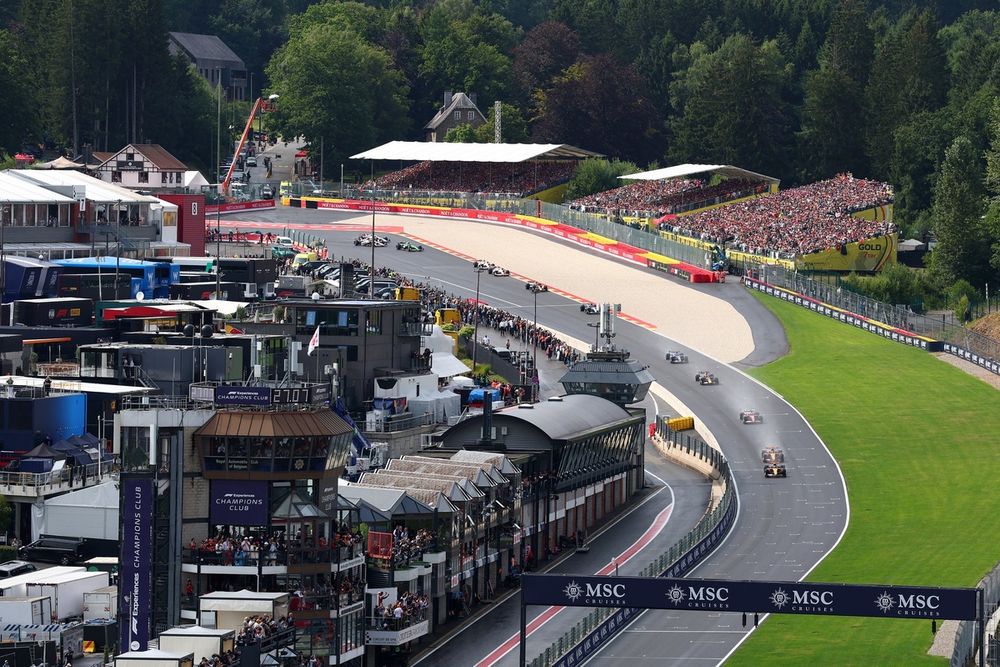Heavy rain within the morning triggered flashbacks of 2021 for a lot of within the Spa-Francorchamps paddock. Again then, unrelenting rain within the Ardennes resulted in a “race” of simply two laps behind the security automotive. 4 years on, a repeat of that situation was averted – however the race was removed from a thriller, regardless of promising elements like a legendary circuit, an attention-grabbing beginning grid, and moist circumstances. The late begin eliminated a lot of the joy, turning a possible fashionable wet-weather basic right into a principally dry race.
After the race, opinions within the paddock had been divided. Carlos Sainz had “respect” for race management, including that at a monitor like Spa, particularly contemplating its current historical past, “higher protected than sorry” ought to be the rule. Ferrari workforce boss Frederic Vasseur added it’s simple to evaluate in hindsight, noting that groups would’ve been the primary to slam race management if an earlier begin had gone flawed.
However, Crimson Bull expressed shock on the prolonged delay. Helmut Marko admitted Crimson Bull had chosen the flawed set-up for the precise circumstances however instructed that “with the proper race director,” the set-up would have been the proper one. Max Verstappen wasn’t impressed by the race director’s calls both: “Should you can’t see correctly, you possibly can at all times raise.”
Poor visibility, although Verstappen needed to race instantly
In actuality, the delay was the results of a number of elements and step-by-step choices, Autosport has discovered after the race. The FIA initially supposed for the race to begin on schedule at 3pm native time, with a formation lap behind the security automotive as the usual protocol in such circumstances. Throughout this lap, race management listened to driver suggestions.
In line with the FIA, nearly all drivers mentioned visibility was nonetheless too poor to race at that time. Just one driver was keen to go racing instantly: Verstappen. The Dutchman voiced his opinion over the radio that a few laps behind the security automotive would have been sufficient to clear many of the standing water on monitor. Alex Albon shared an analogous view behind the wheel and mentioned it could be good to get some laps in earlier than extra rain would hit the monitor.
However primarily based on the suggestions of nearly all of the drivers, a purple flag was proven. At first, the FIA thought of restarting the race after a brief 10-minute pause. Nevertheless, the principles require the race director to problem a “10 minutes warning” to groups forward of a restart. The FIA then seen extra rain was anticipated round that point, successfully ruling out a fast restart.
Lando Norris, McLaren, Oscar Piastri, McLaren
Picture by: Michael Potts / Motorsport Photos
Why did not the three-hour race clock begin operating?
This additionally raised one other query: had the three-hour race clock began but? Even the groups weren’t aligned. McLaren informed Lando Norris in pitlane that it hadn’t, because the race hadn’t formally begun. Haas workforce boss Ayao Komatsu, nevertheless, interpreted it in another way. The confusion is comprehensible. Article 5.4d of the sporting rules states: “If the formation lap for the race is began behind the security automotive, the utmost complete race time of three hours will begin on the time the inexperienced lights on the beginning gantry are illuminated to sign the security automotive will depart the grid in accordance with Article 49.2.”
That is precisely what occurred at 3pm native time. Nevertheless, the FIA clarified that this part of the rules solely applies within the case of an precise race interruption, not in the course of the beginning process. This meant the race had not formally began, and parc ferme circumstances had been nonetheless in impact. Groups weren’t allowed to alter their set-ups in anticipation of drier circumstances.
It seemingly damage groups with a higher-downforce set-up, together with Crimson Bull, however workforce boss Laurent Mekies later clarified that they wouldn’t have modified the set-up anyway, even when it had been allowed by the FIA. “When the formation lap was then suspended, you continue to anticipate to have a good bit of moist operating at that second. I do not assume we’d have modified something, even when parc ferme was open, as a result of we had been anticipating to return on monitor a lot sooner than what we finally did.”
As soon as the race did begin, a number of elements induced the additional security automotive laps and a rolling begin name
In line with the FIA, the post-red flag rain lasted about half-hour. After that, officers waited a bit longer earlier than sending the medical automotive out on monitor at 4pm native time to collect suggestions on the monitor circumstances. Alan van der Merwe reported again to race management that a number of sections nonetheless had important standing water and advisable that marshals be given one other 10 minutes to clear the floor. This introduced the timeline to 4:10pm for the “10 minutes warning,” and automobiles leaving pitlane at 4:20pm. Notably, the FIA initially introduced “race can be resumed,” which was later corrected, because the race had by no means formally began.
As soon as the drivers had been again on monitor, the preliminary plan was to finish simply two laps behind the security automotive. Extra drivers – together with Lewis Hamilton – felt it was protected to go racing at this stage. Nevertheless, race management nonetheless deemed the spray on Kemmel Straight, notably the part after Raidillon, too dangerous. It’s a treacherous a part of the long-lasting monitor, the place visibility is a priority even in dry circumstances throughout incidents. Subsequently, an extra security automotive lap was added.
A fourth lap adopted, however this time for a unique purpose: whether or not the race would start with a standing or rolling begin. Followers naturally hoped for a standing begin, and climate circumstances might have been ok for it, however the FIA needed to take into account one other issue as properly: the beginning grid itself – particularly, the quantity of standing water and the imbalance between the drier and wetter sides. The drier facet had considerably higher grip, whereas the opposite facet nonetheless had puddles, creating an unfair benefit and a possible security concern for half the sector.

Charles Leclerc, Ferrari, Lando Norris, McLaren, Oscar Piastri, McLaren
Picture by: Andy Hone / LAT Photos by way of Getty Photos
Spa as soon as once more uncovered F1’s points within the moist
The outcomes had been a delay of over 90 minutes earlier than the inexperienced flag was proven, and Verstappen commenting: “This isn’t actually moist climate racing for me. I simply discover it a little bit of a disgrace for everybody. You’ll by no means see these basic moist races anymore.”
Above all, the afternoon has as soon as once more highlighted F1’s present struggles within the moist. Most drivers nonetheless don’t love Pirelli’s full wets – with extra modifications anticipated for 2026 – however spray stays the most important problem. Mix that with Spa’s fame, and also you get the cautious method seen on Sunday.
Some groups within the paddock view it as overly conservative, however from the FIA’s perspective, security took absolute priority. Putting the proper stability between security and spectacle stays a troublesome process.
On this article
Be the primary to know and subscribe for real-time information electronic mail updates on these subjects
































